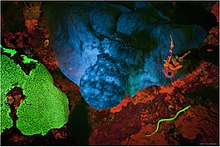fluorescence
fluorescenca


Fluorescence is the emission of light by a substance that has absorbed light or other electromagnetic radiation. It is a form of luminescence. In most cases, the emitted light has a longer wavelength, and therefore lower energy, than the absorbed radiation. The most striking example of fluorescence occurs when the absorbed radiation is in the ultraviolet region of the spectrum, and thus invisible to the human eye, while the emitted light is in the visible region, which gives the fluorescent substance a distinct color that can be seen only when exposed to UV light. Fluorescent materials cease to glow nearly immediately when the radiation source stops, unlike phosphorescent materials, which continue to emit light for some time after.
Fluorescence has many practical applications, including mineralogy, gemology, medicine, chemical sensors (fluorescence spectroscopy), fluorescent labelling, dyes, biological detectors, cosmic-ray detection, vacuum fluorescent displays, and cathode-ray tubes. Its most common everyday application is in energy-saving fluorescent lamps and LED lamps, where fluorescent coatings are used to convert short-wavelength UV light or blue light into longer-wavelength yellow light, thereby mimicking the warm light of energy-inefficient incandescent lamps.
Fluorescence also occurs frequently in nature in some minerals and in many biological forms across all kingdoms of life. This is sometimes referred to as biofluorescence to indicate that the fluorophore derives from a living organism (as opposed to artifically adding a dye or stain). However, in many cases the substance may be fluorescent even if the organism is dead, thus fluorescence is still the preferred term.



